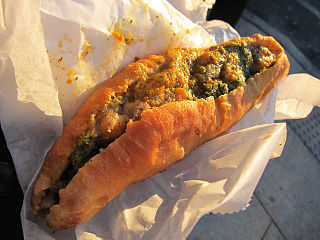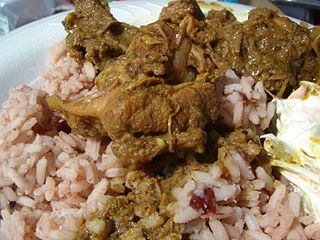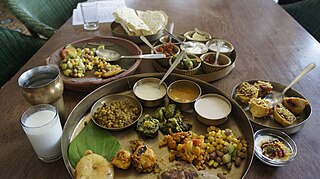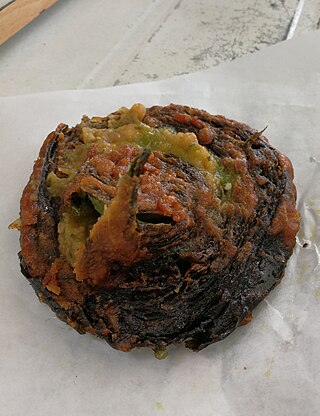
This article is about the demography of the population of Trinidad and Tobago including population density, ethnicity, education level, health of the populace, economic status, religious affiliations and other aspects of the population.

Roti is a round flatbread originating from the Indian subcontinent. It is commonly consumed in many South Asian, Southeast Asian, Caribbean, and Southeast African countries.

Trinidad and Tobago has a unique history and its food is influenced by Indian-South Asian, West African, Creole, European, American, Chinese, Amerindian, and Latin American culinary styles. Trinidadian and Tobagonian food is dominated by a wide selection of dishes, most notably, doubles, roti, pelau, callaloo and curried crab and dumplings. Trinidad and Tobago is also known for its prepared provisions, such as dasheen, sweet potato, eddoes, cassava, yam, soups and stews, also known as blue food across the country. Corresponding to the Blue Food Day event held annually in Trinidad and Tobago.
The culture of Trinidad and Tobago reflects the influence of Indian-South Asian, African, Indigenous, European, Chinese, North American, Latino, and Arab cultures. The histories of Trinidad and Tobago are different. There are differences in the cultural influences which have shaped each island. Trinidad and Tobago is an English-speaking country with strong links to the United Kingdom.

Hinduism in Trinidad and Tobago is the second largest religion. Hindu culture arrived to Trinidad and Tobago in 1845, with the arrival of the first Indian indentured laborers, the overwhelming majority of which were Hindu. According to the 2011 census there were 240,100 declared Hindus in Trinidad and Tobago.

An aloo pie is a Caribbean fast food dish originating from and common in Trinidad and Tobago.
Indo-Guyanese or Indian-Guyanese, are Guyanese nationals of Indian origin who trace their ancestry to India and the wider subcontinent. They are the descendants of indentured servants and settlers who migrated from India beginning in 1838, and continuing during the British Raj.

Doubles is a common street food originating in Trinidad and Tobago. It consists of curried chickpeas served on two fried flatbreads. It is normally eaten during breakfast, but is also eaten occasionally during lunch or as a late night snack and popular hangover food.
Indo-Caribbean Americans or Indian-Caribbean Americans, are Americans who trace their ancestry ultimately to India, though whose recent ancestors lived in the Caribbean, where they migrated beginning in 1838 as indentured laborers. There are large populations of Indo-Trinidadian and Tobagonians and Indo-Guyanese along with a smaller population of Indo-Surinamese, Indo-Jamaicans and other Indo-Caribbeans in the United States, especially in the New York metropolitan area and Florida. The Washington metropolitan area, Texas, and Minnesota also have small numbers of Indo-Guyanese and Indo-Trinidadians. Indo-Caribbean Americans are a subgroup of Caribbean Americans as well as Indian Americans, which are a subgroup of South Asian Americans, which itself is a subgroup of Asian Americans.

Goat curry, curried goat, or curry goat is a curry dish prepared with goat meat, originating from the Indian subcontinent. The dish is a staple in Southeast Asian cuisine, Caribbean cuisine, and the cuisine of the Indian subcontinent. In the Caribbean and Southeast Asia, the dish was brought to the region by the Indian diaspora, and has subsequently influenced the respective local cuisines. This dish has also spread throughout the Indo-Caribbean diaspora in North America and Europe.

Gujarati cuisine is the cuisine of the Indian state of Gujarat. The typical Gujarati thali consists of rotli, dal or curry, rice, and shaak. The thali will also include preparations made from pulses or whole beans such as moong, black eyed beans etc., a snack item (farsaan) like dhokla, pathra, samosa, fafda, etc. and a sweet (mishthaan) like mohanthal, jalebi, sevaiya etc.

Caribbean Hindustani is an Indo-Aryan language spoken by Indo-Caribbeans and the Indo-Caribbean diaspora. It is a koiné language mainly based on the Bhojpuri and Awadhi dialects. These Hindustani dialects were the most spoken dialects by the Indians who came as immigrants to the Caribbean from Colonial India as indentured laborers. It is closely related to Fiji Hindi and the Bhojpuri-Hindustani spoken in Mauritius and South Africa.
Bhojpuri cuisine is a style of food preparation common among the Bhojpuri people of Bihar, Jharkhand and eastern Uttar Pradesh in India, and also the Terai region of Nepal. Bhojpuri foods are mostly mild and tend to be less hot in terms of spices used. The cuisine consists of both vegetable and meat dishes.

Chicken curry or curry/curriedchicken is a South Asian dish originating from the Indian subcontinent. It is common in the cuisine of the Indian subcontinent, Caribbean, Southeast Asia, Great Britain, and Kenya. A typical curry from the Indian subcontinent consists of chicken stewed in an onion- and tomato-based sauce, flavoured with ginger, garlic, tomato puree, chilli peppers and a variety of spices, often including turmeric, cumin, coriander, cinnamon, and cardamom. Outside of South Asia, chicken curry is often made with a pre-made spice mixture known as curry powder.
Indo-Belizeans, also known as East Indian Belizeans, are citizens of Belize of Indian ancestry. The community made up 3.9% of the population of Belize in 2010. They are part of the wider Indo-Caribbean community, which itself is a part of the global Indian diaspora.

Baigan bharta, also spelled bainganbharta or baigan chokha is an Indian dish prepared by mashing or mincing grilled eggplant (baigan) with tomato, onion, herbs and spices, with variations being common from chef to chef. Traditionally, cooking the eggplants over charcoals, inside of a tandoor, barbecue grill or oven, or even directly applying flame to the outside of the fruit infuses the dish with a smoky flavour; the blackened skin is then easily peeled and the eggplant may be further prepared.

Originating in the Caribbean with Indian roots, a roti is a wrap style sandwich filled with either curried or sometimes stewed meats or vegetables wrapped inside a dhalpuri, paratha, or dosti roti. Roti is eaten widely across the Caribbean. As Indo-Caribbeans immigrated to other countries, especially in North America and Europe, they brought with them the roti and opened roti shops to sell it.

Pholourie, also spelled phulourie or phoulourie, is a snack food commonly eaten in Trinidad and Tobago, Guyana, Suriname and other parts of the Caribbean. It consists of fried, spiced split pea and flour dough balls that are served with a chutney.

Vada, vadai, wada, bara, or bora is a category of savoury fried snacks native to India. Vadas can be described variously as fritters, cutlets, or dumplings. Vadas are sometimes stuffed with vegetables and traditionally served with chutneys and sambar.

Saheena is a street food and snack of Indian origin in the cuisine of Trinidad and Tobago.























